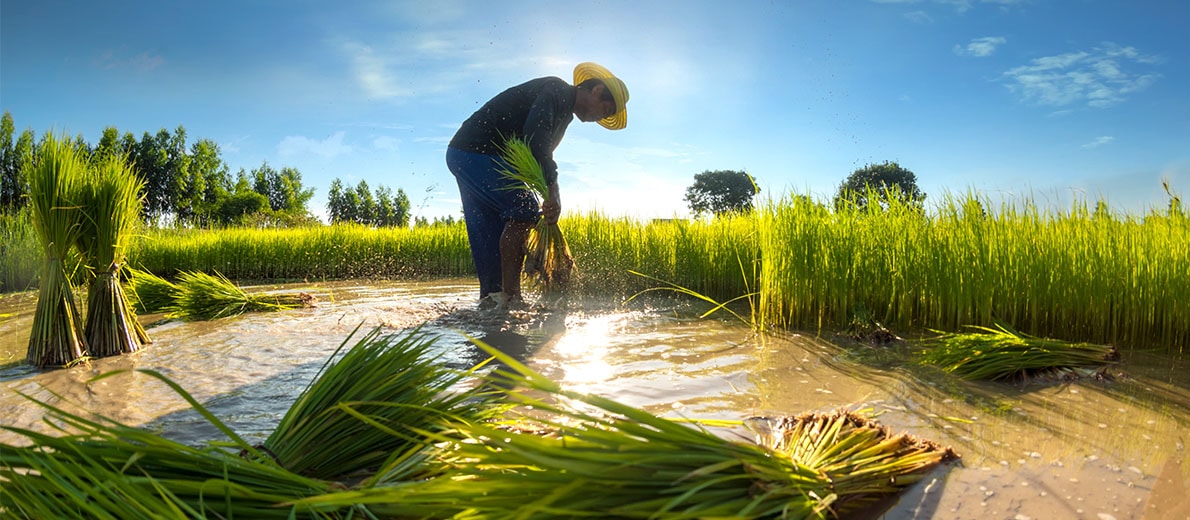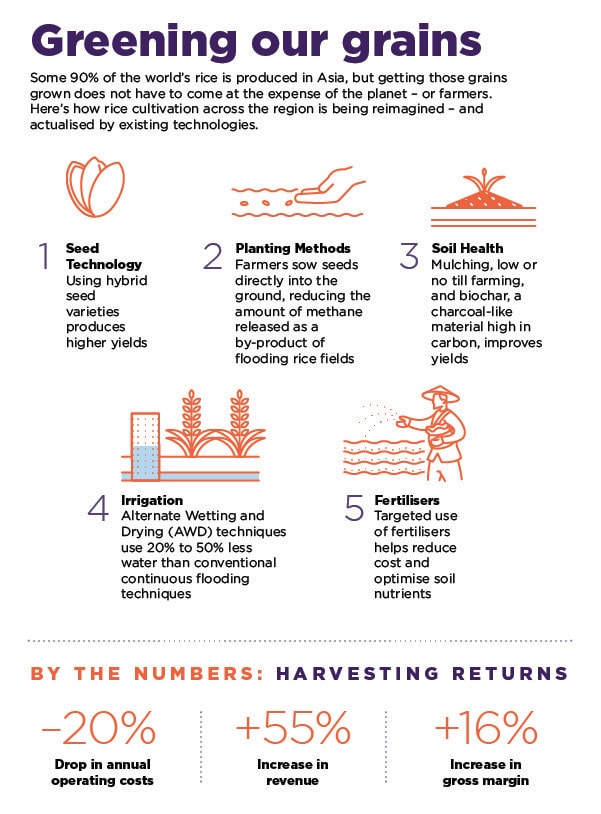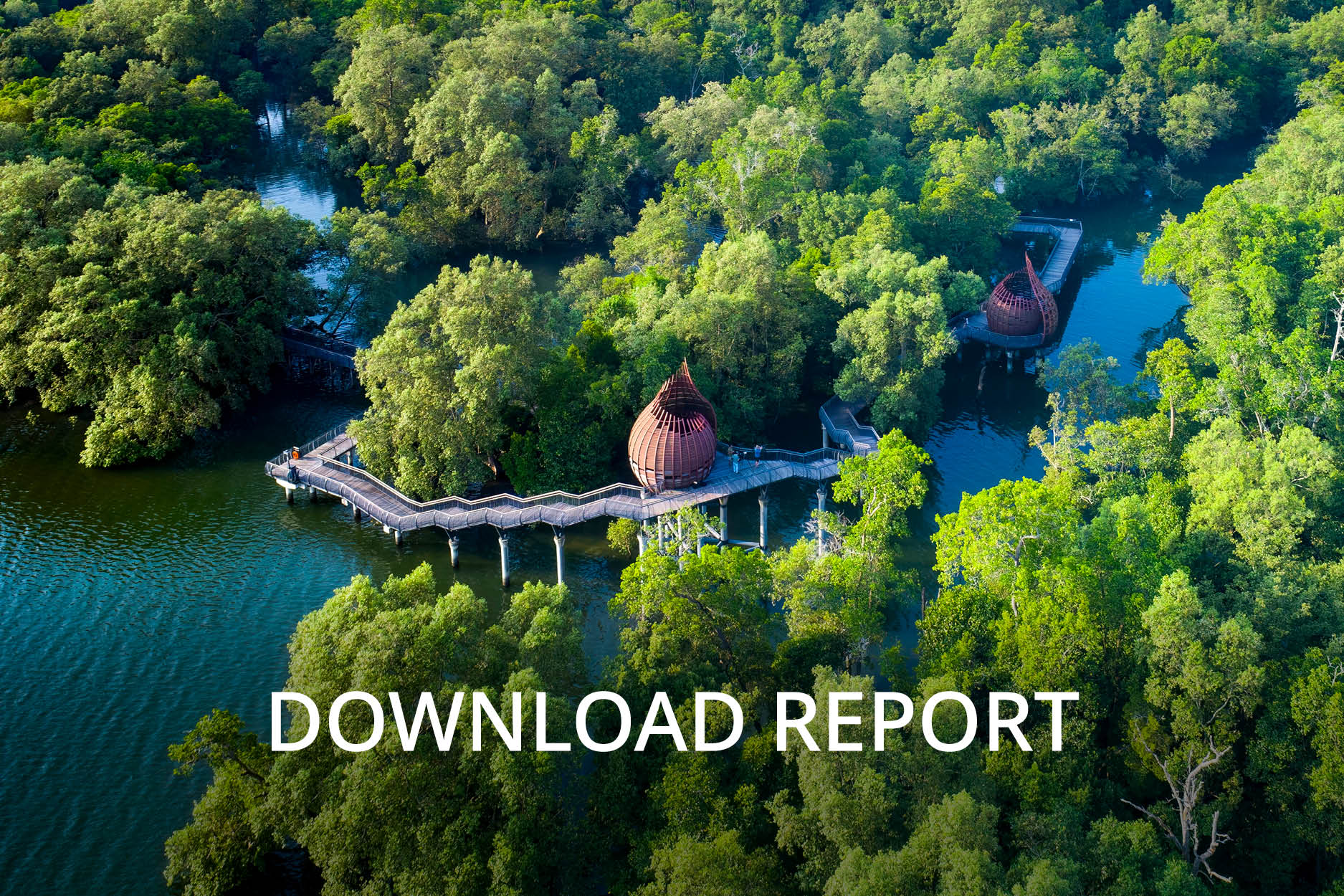Burning Questions: Putting food on greener paths
Burning Questions: Putting food on greener paths

In brief:
● The agri-food sector is responsible for a quarter of Asia’s CO2 equivalent emissions
● The latest Asia Food Challenge report identifies 23 readily available technologies and practices that can significantly reduce these emissions
● Reducing emissions today will have greater impact on global warming than reducing emissions in the future
The latest edition of The Asia Food Challenge highlights opportunities to decarbonise one of the region’s largest contributors to global warming, while also increasing food production and improving livelihoods in the agri-food sector
Asia’s landscape is dotted with hundreds of millions of farms producing the meat, vegetables, and grains we eat. But the agri-food sector is also responsible for a quarter of the region’s total carbon emissions. This makes it a key focus in any attempt to decarbonise.
The latest edition of The Asia Food Challenge, jointly authored by Temasek, PwC, Rabobank, and Terrascope, identifies more than 20 readily available technologies and practices that are suitable to the region, and can significantly reduce the greenhouse gas (GHG) emissions responsible for climate change.
Anuj Maheshwari, Head of Agri-Food at Temasek, answers your Burning Questions on the scale of Asia’s agri-food emissions, opportunities for action, and why they should be implemented sooner rather than later.
Decarbonising Asia’s agri-food sector is critical for reducing the effects climate change is having on our food resilience. To do so, we need to prioritise the deployment of existing, readily available, and actionable solutions that can be scaled across the agri-food value chain, and channel capital to catalyse these solutions to accelerate decarbonisation in Asia and globally. This will enable the transition towards a greener and more sustainable agri-food system so every generation prospers.
– Anuj Maheshwari, Head, Agri-Food, Temasek
Q: Why are we focusing on Asia? Aren’t most emissions from the agri-food industry coming from big industrialised farms in the West?
Anuj: Asia is responsible for about 42% of the CO2 equivalent emissions generated by the agri-food sector globally – despite using just 35% of the world’s arable land. This is due to a number of reasons. The region is home to two-thirds of the world’s 600 million smallholder farms, which typically have less access to technology, and are therefore less efficient than large mechanised farms. In fact, at least two-thirds of the emissions from Asia’s agri-food value chain occurs before the produce leaves the farm. Asia also produces 90% of the world’s rice and is home to approximately 40% of the world’s cattle. Both rice cultivation and the rearing of ruminant livestock release methane, a greenhouse gas with a global warming potential 28 times higher than carbon dioxide over a 100-year period.
Q: Do we have the means to reduce these emissions?
Anuj: The latest Asia Food Challenge report identifies 23 technologies and practices that can be applied in the Asian context. What’s also important is that these technologies and practices are readily available, and have the potential to create an immediate and positive impact not just on carbon emissions but also farm profitability by improving efficiency and yields. In fact, increasing the adoption of these technologies represents the most feasible and impactful path to decarbonising Asia’s agri-food sector.
Q: How do some of these technologies and practices work?

Q: Shouldn’t we wait for more advanced technologies that can make a bigger impact?
Anuj: It is critical to act now, as we approach climate tipping points. A tonne of carbon reduced today will have greater impact on mitigating climate change than a tonne reduced in the future, after climate tipping points have been crossed. Technologies and practices that are already available and can be deployed today have the potential to reduce CO2 equivalent emissions in the Asian agri-food sector by approximately 12% (840 Mt CO2e) by 2030. This is equivalent to the total emissions from the global aviation industry in 2022.
Q: Why should climate investors put their money into agri-food?
Anuj: Beyond the opportunity to lower carbon emissions, there are several other drivers for investment. Asia’s population is increasing, as is its middle class. This will translate into higher demand as well as demand for better quality food, typically leading to higher profit margins for sellers. Technology adoption will improve both efficiency and yield. Meanwhile, we see that governments keen to secure their food supply chains are also investing in the sector.
Q: What are some of the key challenges – and can they be overcome?
Anuj: Asia has a high proportion of smallholder farms – approximately two-thirds of the world’s 600 million smallholder farms are located in the region. How can we get them to adopt these technologies and practices? Digital platforms, accessible through mobile phones, offer one solution. By providing farmers with access to agronomic advice, for example on-demand trends or the weather, these platforms allow them to plan better, reducing costs and improving yields. On a broader level, agri-food has received less focus than other large emitters, like energy. Given the significant contribution of the agri-food sector to global emissions, this needs to change. The focus on reducing emissions must, however, be balanced with positive impacts on the farmers’ livelihoods as well as food production.
Q: As a consumer, what can I do?
Anuj: Consumers can drive change through their purchasing decisions and actions. Food waste is another significant contributor to global carbon emissions. You can minimise food wastage by planning your meals or creating new dishes with leftovers. Buying food from local sources can also reduce the carbon footprint of your next grocery run.


